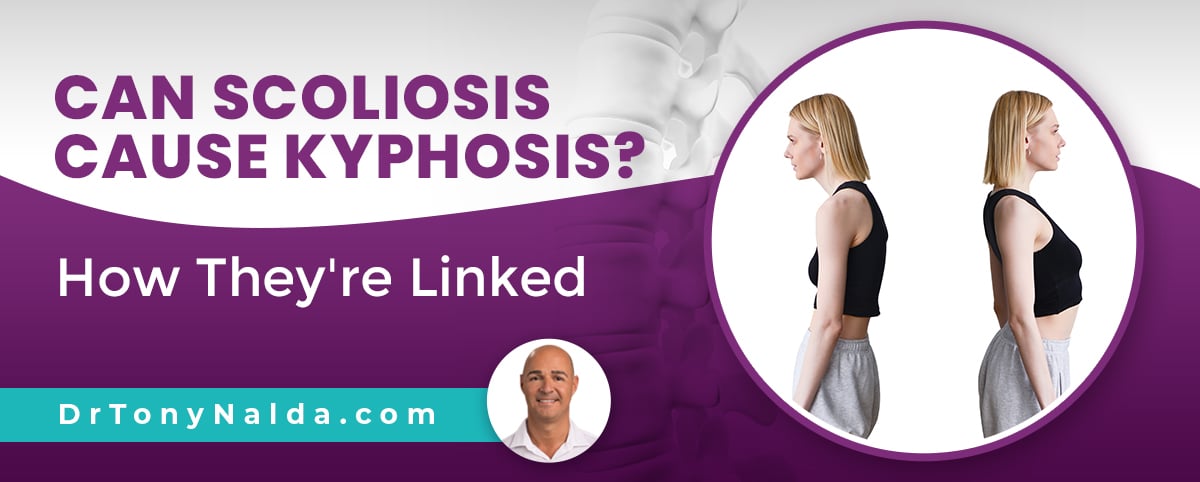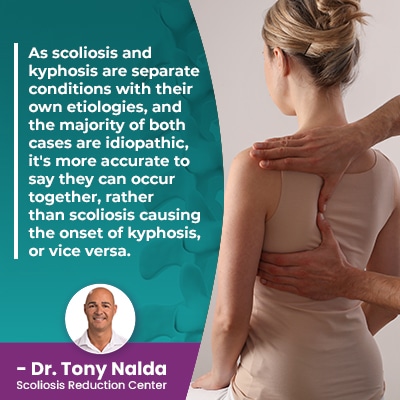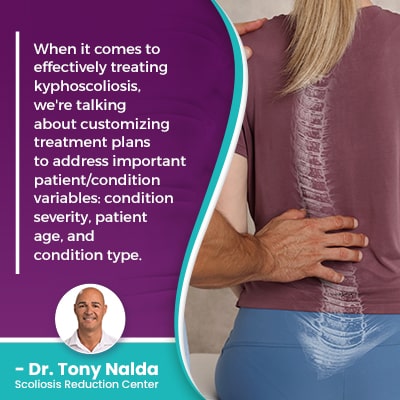Can Scoliosis Cause Kyphosis? How They're Linked

Scoliosis is the development of an unnatural sideways spinal curvature with rotation, while kyphosis is the development of an excessive outward-bending spinal curve that causes a rounding forward of the shoulders and upper back. Scoliosis and kyphosis are both thought to be multifactorial, so can be caused by multiple factors that can vary from one patient to the next.
While there are different types of scoliosis and kyphosis with various causes, the majority of both conditions are classified as idiopathic, so it's more accurate to say that scoliosis and kyphosis can occur together, but are not caused by one another. When they present together, this is diagnosed as kyphoscoliosis.
Let's explore the connection between scoliosis and kyphosis by first defining each condition and then taking a look at how and why they occur together.
Table of Contents
What is Scoliosis?
Scoliosis is the development of an unnatural lateral curvature of the spine that not only bends unnaturally to the side, but also twists, making it a 3-dimensional condition.
A scoliotic curve also has to be of a minimum size to be considered a true scoliosis, and that means a minimum Cobb angle measurement of at least 10 degrees.
A patient's Cobb angle is known as the gold standard in the assessment and diagnosis of scoliosis, and is determined during X-ray by drawing lines from the tops and bottoms of the curve's most-tilted vertebrae; the resulting angle is expressed in degrees and classifies conditions in terms of severity:
- Mild scoliosis: Cobb angle measurement of between 10 and 25 degrees
- Moderate scoliosis: Cobb angle measurement of between 25 and 40 degrees
- Severe scoliosis: Cobb angle measurement of 40+ degrees
- Very-severe scoliosis: Cobb angle measurement of 80+ degrees
In addition, scoliosis is progressive, meaning it's in its very nature to get worse over time, which is why proactive treatment is so important.
Scoliosis introduces a lot of uneven forces to the body, and those uneven forces disrupt the body's overall symmetry and can cause a number of symptoms felt throughout, and not just in the back.
Adult scoliosis is generally diagnosed because of pain, while uneven shoulders and hips are often the condition's earliest signs in children.
So because scoliosis is an unnatural 3-dimensional spinal condition, it occurs in the sagittal, coronal, and frontal plane, and this is a significant difference between scoliosis and kyphosis.
What is Kyphosis?
The spine has three main sections: the cervical spine (neck), the thoracic spine (middle/upper back), and the lumbar spine (lower back).
Each spinal section has its own characteristic curvature type, and the spine's healthy curves make it stronger, more flexible, and better able to handle mechanical stress incurred during activity.
In order for the spine to function optimally, its vertebrae need to be aligned, and this means the healthy and natural spinal curves are in place.
Kyphosis refers to the spine's backward curvature that bends away from the front of the body, and this curvature type is found in the thoracic spine, and if a person's level of kyphosis becomes excessive, this means the middle/upper back develops an exaggerated curvature that causes a roundback appearance.
A healthy range of thoracic kyphosis would fall between 20 and 45 degrees, with increased kyphosis, also known as hyperkyphosis, being commonly diagnosed at 45+ degrees.
So as kyphosis refers to the spine's backward curve, it occurs in the sagittal plane, unlike scoliosis that occurs in all three anatomical planes.
What's Kyphoscoliosis?
 There are different types of scoliosis: idiopathic scoliosis, adolescent idiopathic scoliosis, adult idiopathic scoliosis, neuromuscular scoliosis, degenerative scoliosis, and congenital scoliosis.
There are different types of scoliosis: idiopathic scoliosis, adolescent idiopathic scoliosis, adult idiopathic scoliosis, neuromuscular scoliosis, degenerative scoliosis, and congenital scoliosis.
There are also different types of kyphosis: postural kyphosis, Scheuermann's disease, and congenital kyphosis.
If an abnormal curvature of the spine was to engage the sagittal plane and the coronal plane, this is referred to as kyphoscoliosis, also known as scoliosis with a kyphosis.
As scoliosis and kyphosis are separate conditions with their own etiologies, and the majority of both cases are idiopathic, it's more accurate to say they can occur together, rather than scoliosis causing the onset of kyphosis, or vice versa.
While each case is unique and will depend on a number of key patient/condition variables, many patients will experience some of the following symptoms of kyphoscoliosis:
- A roundback appearance (excessively rounded forward upper back and shoulders)
- Uneven shoulders
- Uneven shoulder blades
- Uneven hips
- Arms and legs that appear to hang at different lengths
- Postural deviation that gets more noticeable over time
- Back pain (mild to severe pain)
- Muscle weakness and/or imbalance
- Fatigue
- Neurological symptoms (due to nerve compression)
- Digestive issues
- Lung impairment
In most spinal conditions, the area of the body located closest to the affected spinal section is the most likely to feel the condition's direct effects.
Kyphoscoliosis most often affects the thoracolumbar (lower thoracic and upper lower spine), but can also occur in the cervicothoracic (lower cervical spine and upper thoracic spine).
In most cases, moderate kyphoscoliosis involves a Cobb angle measurement of between 25 and 100 degrees, and severe kyphoscoliosis has a Cobb angle of 100+ degrees.
Cases of kyphoscoliosis are generally more severe cases than when a person just has scoliosis, or just kyphosis, because it means the unnatural spinal curve develops across multiple planes, making it affect more of the spine, and in turn, it will affect more of the body.
Kyphoscoliosis Treatment
 When it comes to effectively treating kyphoscoliosis, we're talking about customizing treatment plans to address important patient/condition variables: condition severity, patient age, and condition type.
When it comes to effectively treating kyphoscoliosis, we're talking about customizing treatment plans to address important patient/condition variables: condition severity, patient age, and condition type.
An important part of treatment, particularly when treating children, is monitoring not only how the spine is responding to treatment, but also how it responds to growth; growth is the condition's trigger for progression.
Here at the Scoliosis Reduction Center, I apply conservative measures and integrate multiple different types of treatment so conditions can be impacted on every level: condition-specific chiropractic care, physical therapy, corrective bracing, and rehabilitation.
One of my goals of treatment is to help patients avoid scoliosis surgery by preventing progression, the development of severe symptoms, and increasing condition-effects caused by abnormal alignment of the spine.
I apply chiropractic care that can include a number of techniques and manual adjustments with the goal of adjusting the position of the curve's most-tilted vertebrae back into alignment with the rest of the spine.
Physical therapy can help patients increase their core strength so their spines are optimally supported by strong surrounding muscles, and it can also help address poor posture and any related muscle imbalance.
Corrective scoliosis bracing is also a helpful facet of treatment, particularly with young patients whose spines are still growing, and rehabilitation involves a series of custom-prescribed home exercises to further stabilize and heal the spine.
Regardless of severity, the best time to start kyphoscoliosis treatment is always now; while there are no treatment guarantees, early detection is associated with treatment success.
Conclusion
Scoliosis is a spinal condition that involves a structural abnormality within the spine itself, and as such, it has to be impacted, first and foremost, on a structural level to be treated effectively; kyphosis can be postural, or have structural causes.
Both kyphosis and scoliosis involve a loss of one or more of the spine's healthy curves, and when this happens, uneven forces are introduced to the body, and the biomechanics of the spine are disrupted.
When scoliosis and kyphosis present together, this means the spine is unnaturally curved in the frontal and sagittal plane, and this means the unnatural spinal curve is going to involve more than one spinal section and can be severe.
When it comes to treating kyphoscoliosis, determining the underlying cause of each condition is important as this means addressing the condition itself, and not just its symptoms.
Through integrating multiple different forms of treatment, plans can be fully customized, and with monitoring throughout to see how the spine is responding to treatment and growth, the condition's progressive nature can be counteracted with proactive treatment.
When the spine's healthy curves are in place, its vertebrae are aligned in a straight and neutral position as they should be, and spinal alignment allows the spine to functional optimally; if the spine loses a healthy curve, it affects the other spinal curves, the spine's surrounding muscles and nerves, and the entire body as uneven forces are introduced.
A diagnosis of kyphoscoliosis is reached through a physical examination that includes taking the patient's family and medical history, conducting an Adan's forward bend test, and observing a patient's posture and gait.
If a physical examination turns up indicators for scoliosis or kyphosis or both, an X-ray is ordered to really see what's happening in and around the spine, to determine a patient's angle of trunk rotation, and their Cobb angle measurement.
Degenerative changes to the spine that occur with age also make it more vulnerable to the development of a number of spinal conditions/issues.
When proactive treatment is applied, there are fewer limits to what can be achieved, curve progression can be managed, and the need for surgical intervention can be avoided, so don't hesitate to reach out for further guidance and support.
Dr. Tony Nalda
DOCTOR OF CHIROPRACTIC
After receiving an undergraduate degree in psychology and his Doctorate of Chiropractic from Life University, Dr. Nalda settled in Celebration, Florida and proceeded to build one of Central Florida’s most successful chiropractic clinics.
His experience with patients suffering from scoliosis, and the confusion and frustration they faced, led him to seek a specialty in scoliosis care. In 2006 he completed his Intensive Care Certification from CLEAR Institute, a leading scoliosis educational and certification center.
About Dr. Tony Nalda
 Ready to explore scoliosis treatment? Contact Us Now
Ready to explore scoliosis treatment? Contact Us Now





